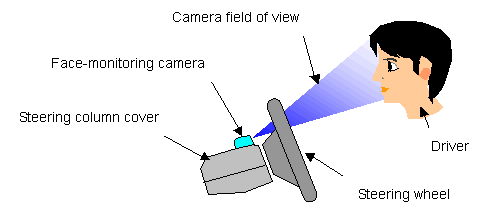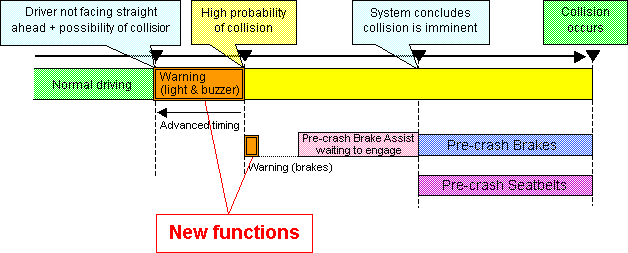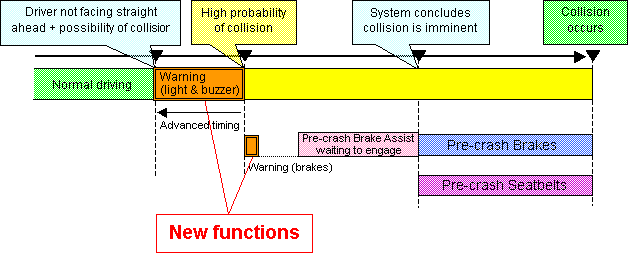Sep. 06, 2005
Toyota Enhances Pre-crash Safety System With Driver-monitoring Function
Tokyo ― TOYOTA MOTOR CORPORATION (TMC) announced today that it has developed a new version of its Pre-crash Safety System that provides early warning of an imminent collision when it detects the driver is likely not looking straight ahead. This new feature―a response to data that suggests that most vehicle accidents are caused by lack of driver awareness*1―is a world’s first*2 and will be offered on a Lexus-brand vehicle due to debut in Japan in the spring of 2006.
While Toyota's Pre-crash Safety System until now has centered on the detection of other vehicles and obstacles on the road ahead, the newly enhanced system takes into consideration, for the first time, the state of the driver. Using a camera mounted on the steering column and an image-processing computer, the system detects the orientation of the driver's face. If the system reads that the driver is not facing forward when it determines that the probability of a collision is high, it will warn the driver sooner than when the driver is facing forward, aiming to lessen collision injuries.
Toyota became the first automaker to develop a radar-based collision safety system when it came out with its Pre-crash Safety System in February 2003; the system uses millimeter-wave radar and a camera to detect other vehicles and obstacles on the road ahead and warns the driver when a collision is imminent. Since then, Toyota has constantly and actively continued to further develop this advanced safety technology. In August 2003, Toyota added to the system Pre-crash Brakes, a function that applies the brakes when the driver fails to react in time. In July 2004, it adopted an "image fusion" method, which adds camera-gained image information to information obtained by millimeter-wave radar. And with the latest development, Toyota is now advancing its Pre-crash Safety System by not only considering obstacles in the path of travel, but also by developing systems that monitor the driver.
In an attempt to contribute to the complete elimination of traffic casualties―which can be said to be the ultimate hope of a mobile society―Toyota intends to strengthen its wide-ranging traffic safety initiatives by developing safer vehicles that feature the Toyota GOA*3 passive safety body, the Pre-crash Safety System and various control technologies such as VDIM*4 and through conducting traffic safety awareness activities and participating in efforts to improve the traffic environment.
*1.2004 data from the Institute for Traffic Accident Research and Data Analysis (ITARDA)
*2.Based on a survey conducted by Toyota in August 2005
*3.Global Outstanding Assessment (safety assessment standards that aim to be one of the best in the world)
*4.Vehicle Dynamics Integrated Management
While Toyota's Pre-crash Safety System until now has centered on the detection of other vehicles and obstacles on the road ahead, the newly enhanced system takes into consideration, for the first time, the state of the driver. Using a camera mounted on the steering column and an image-processing computer, the system detects the orientation of the driver's face. If the system reads that the driver is not facing forward when it determines that the probability of a collision is high, it will warn the driver sooner than when the driver is facing forward, aiming to lessen collision injuries.
Toyota became the first automaker to develop a radar-based collision safety system when it came out with its Pre-crash Safety System in February 2003; the system uses millimeter-wave radar and a camera to detect other vehicles and obstacles on the road ahead and warns the driver when a collision is imminent. Since then, Toyota has constantly and actively continued to further develop this advanced safety technology. In August 2003, Toyota added to the system Pre-crash Brakes, a function that applies the brakes when the driver fails to react in time. In July 2004, it adopted an "image fusion" method, which adds camera-gained image information to information obtained by millimeter-wave radar. And with the latest development, Toyota is now advancing its Pre-crash Safety System by not only considering obstacles in the path of travel, but also by developing systems that monitor the driver.
In an attempt to contribute to the complete elimination of traffic casualties―which can be said to be the ultimate hope of a mobile society―Toyota intends to strengthen its wide-ranging traffic safety initiatives by developing safer vehicles that feature the Toyota GOA*3 passive safety body, the Pre-crash Safety System and various control technologies such as VDIM*4 and through conducting traffic safety awareness activities and participating in efforts to improve the traffic environment.
*1.2004 data from the Institute for Traffic Accident Research and Data Analysis (ITARDA)
*2.Based on a survey conducted by Toyota in August 2005
*3.Global Outstanding Assessment (safety assessment standards that aim to be one of the best in the world)
*4.Vehicle Dynamics Integrated Management
• System configuration
• Layout

• Layout

• Order of Operation








